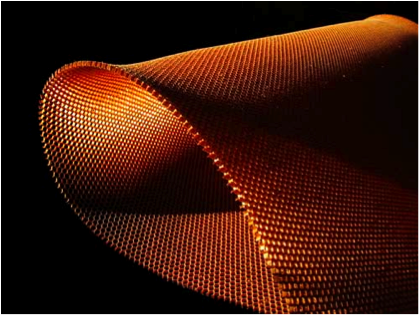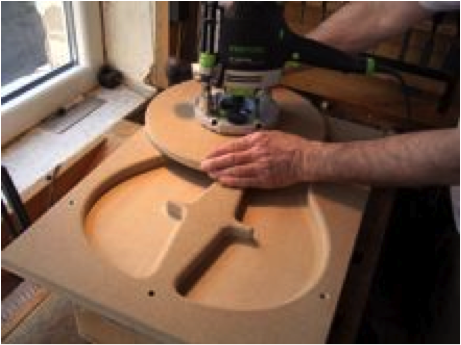CONSTRUCTION OF A COMPOSITE GUITAR TOP
Report of a presentation by Gernot Wagner on May 14, 2010 in the castle of Hingene, Belgium.
Author: Chris Van Heddegem, CMB Puurs
Abstract
At the occasion the Corde Factum guitar festival on May 14, 2010 Gernot Wagner gave a presentation on how to construct a composite guitar top1. Materials, tools and working methods were discussed.
Introduction
The first double top guitar was built by Matthias Dammann (MD) in Germany around the late 1980s. MD had the idea to construct a top from very thin sheets of tone wood with in between a structure of diagonal strips. The result was good but the production process itself was complicated.
Following MD’s idea, Gernot Wagner (GW) was the first guitar maker to develop independently from MD a composite top for the guitar where the diagonally glued strips were replaced by Nomex2, a material that was originally intended as a lightweight material for the aircraft industry. Since then the term double top is usually understood as a top consisting of Nomex honeycomb sandwiched between two thin layers of tone wood.
The first guitar according to this principle was built by GW in 1996 and is still in great condition.
Earlier in the period 1950-1980, several luthiers (eg Ovation, Rainsong, Canadian Schwartz Guitars, ...) started applying graphite in the construction of their guitars. The problem with graphite in these guitars is that the descant predominates and that the bass does not sound right.
Nomex honeycomb structure3
 Nomex is made from meta-aramid (aromatic polyamide), on the market since 1967, both in the form of fibers and sheets. The production of Nomex honeycomb starts with aramid sheets, calendered as usual in the paper industry. The aramid sheets are glued together with a special adhesive according to specific lines, after sawing and stretching the hexagonal cell pattern is achieved. Finally, the sheets are still impregnated with phenolic resin and cured at 180 ° to fixate the shape.
Nomex is made from meta-aramid (aromatic polyamide), on the market since 1967, both in the form of fibers and sheets. The production of Nomex honeycomb starts with aramid sheets, calendered as usual in the paper industry. The aramid sheets are glued together with a special adhesive according to specific lines, after sawing and stretching the hexagonal cell pattern is achieved. Finally, the sheets are still impregnated with phenolic resin and cured at 180 ° to fixate the shape.
The reasons to use Nomex honeycomb (further abbreviated as Nomex) are its light weight (specific gravity 29 kg/m3- this is 1/20 of the weight of spruce), the fact that it can be glued with epoxy or polyurethane (PUR) under vacuum and a open structure which resembles more or less the structure of spruce when magnified. Nomex withstand a pressure of 50,000 kPa (50 kg/cm2).
The Nomex sheets used in guitar construction are 1.5 mm thick, this is also the smallest thickness that is commercially available4. The sheets have a different stiffness in the longitudinal and transverse direction, which makes it possible to influence slightly the behaviour of the top.
Construction Method
The 2 layers of tone wood (usually 1 layer spruce and 1 layer cedar) are thicknessed to 0.6 mm. GW does not thickness to less than 0.6mm to avoid the Nomex structure to shine through the spruce top. Thickness is controlled with a thickness meter, the tone wood being held vertically together with an MDF board of uniform thickness.
The upper sheet of tone wood of the top (spruce) is however not thicknessed to the same degree over the whole surface. First, one side is planed smooth and a rosette of 0.3 mm thick inlaid. Initially, the rosette will obviously be thicker but when the top is finished it should not be thicker in order not to fall through the top. The finish of the top should be perfect at this stage; once the guitar is built it is not possible to sand the top because then the honeycomb structure would become strongly apparent.
 To further process the upper part of the top a vacuum tray with perforated worktop is required (MDF board with about 1300 holes of 1.5 to 2 mm diameter). This worktop is completely flat (GW constructs the guitar top completely flat).
To further process the upper part of the top a vacuum tray with perforated worktop is required (MDF board with about 1300 holes of 1.5 to 2 mm diameter). This worktop is completely flat (GW constructs the guitar top completely flat).
To construct an arched top would be difficult, but is in principle feasible; the problem is however that the guitar top then becomes too stiff. From time to time the vacuum worktop must flattened, for this purpose GW uses a glass plate of 8 to 10 mm thick, with glued on sandpaper.
The vacuum pump must be preferably an oil-free type (in the case of improper use of an oil-pump oil from the vacuum pump can be sucked up). GW uses a vacuum pump for continuous use with a flow rate of 50 l / min. The desired pressure is 50 to 60 kPa, which is higher than the vacuum the pump can achieve. In order to achieve the desired vacuum level a leak is created at the level of the vacuum press; more about this follows further. In principle, one could also use a vacuum cleaner as a vacuum source (approximately 80 kPa), but in that case check first if the vacuum cleaner can operate sufficiently long (at least 20 min) before the thermal protection shuts off the vacuum cleaner. You can give it a try with the workshop vacuum cleaner as these are intended for continuous use.
Furthermore, we need:
A router jig in MDF with a recess for the area where the Nomex must be glued on: see picture above 5.
A stable router with 2 concentric copying rings (1 for the full depth and 1 for the bevels), with a 12 mm collet, mounted on a wooden disk, see picture below6.
Routing
 The spruce top is positioned on the vacuum worktop (rosette below), with the router jig on top. The routing depth is set with feeler gauge. The tone wood is routed to a thickness of 0.6 mm using the largest copying ring, this should preferably be done in 2 steps. Then using the smaller copying ring the edges are bevelled at the periphery from 2.1 mm to 0.6 mm (see picture 6 opposite). Under the bridge, the edge of the rosette, the centre and the edge of the upper tone wood sheet the thickness is 2.1 mm. After routing sand with 240 grit sandpaper.
The spruce top is positioned on the vacuum worktop (rosette below), with the router jig on top. The routing depth is set with feeler gauge. The tone wood is routed to a thickness of 0.6 mm using the largest copying ring, this should preferably be done in 2 steps. Then using the smaller copying ring the edges are bevelled at the periphery from 2.1 mm to 0.6 mm (see picture 6 opposite). Under the bridge, the edge of the rosette, the centre and the edge of the upper tone wood sheet the thickness is 2.1 mm. After routing sand with 240 grit sandpaper.
Gluing
Before starting gluing the humidity of the wood must be measured with a wood hygrometer. 6% humidity is good but 8% is better. Actually, the wood humidity is only important if PUR glue is used and this is the type of glue that GW uses. PUR glue requires moisture in order to cure. The wood humidity does not matter if one would use epoxy glue.
It is recommended to test the processing time of the PUR glue beforehand. If it takes at least 20 minutes before the glue starts foaming it is OK. A processing time of at least 20 minutes is needed in order to be able to work comfortably.
The spruce sheet is put in the vacuum press, routed side up.
A plastic film is stuck onto the Nomex to serve as a carrier (the kind of self-adhesive film which is used to cover books, preferably a fairly solid film). Nomex and carrier are cut out to cover the routed out surface including the bevelled edges. GW also adheres a strip of painter's tape on the 2 outside corners of the plastic film to take up the Nomex / plastic film when the glue is applied.
PUR glue is applied to the Nomex with a neoprene roller with smooth surface without exerting pressure and the Nomex is laid in the thinned part of the top (glued side down). On top op this, a perforated plastic film is applied, then a bleedermat (eg, a filter mat as used in fume hoods) and finally the closing film of the vacuum press. Vacuum is applied and the pressure is controlled to about 50 to 60 kPa by creating a controlled leak at the vacuum press level. As a result fresh air will be sucked continuously into vacuum press and the air humidity will contribute to the curing of the PUR adhesive.
After curing, the plastic film is removed, the Nomex sanded smooth with a long sanding block (grit 240) and brushed clean. The neoprene roller is again used to apply PUR glue to the entire surface of Nomex and wood, and the 2nd layer of tone wood (cedar) is applied, then follows the bleedermat and the closing film of the vacuum press. Then the whole vacuum press is inverted so that the cedar layer will be at the bottom and PUR glue applied to the Nomex can flow on the cedar, then the vacuum is connected. After curing of the glue we are holding now a guitar top that is as rigid as a classical top but 40% lighter. This top cannot be sanded or the Nomex structure will clearly appear through the top. Cleaning with naphtha or acetone is possible.
In principle one could also use epoxy glue, one problem is that this glue impregnates the wood. By selecting a thixotropic quality of glue this problem should be minimized. Also, a sufficiently thick layer of glue should be applied because epoxy glue does not expand during curing.
Gluing without the use of the vacuum press should also be possible. In that case GR recommends using a filter mat to distribute the pressure evenly, and a MDF board charged with weights.
Strutting
classical fan strutting.
Glues used
Top: Tidebond
Strutting: PUR glue
Veneer: PUR glue
Neck joint: PVA (polyvinyl acetate) glue
Finger board: PUR glue
Edge Inlay: PVA glue
GLOSSARY
1. Other names for composite top : double top, sandwich top
2. Trademark of DuPont Chemical Co.)
3. Picture from website Fritz Mueller, classicalguitars.ca/doubletops.htm
4. Nomex in non-industrial quantities is available from R&G Faserverbundwerkstoffe GmbH Postfach 1145 D-71107 Waldenbuch, Aerospace Composite Products, LMI, ...
5. Picture G Wagner
6. Picture G Wagner



